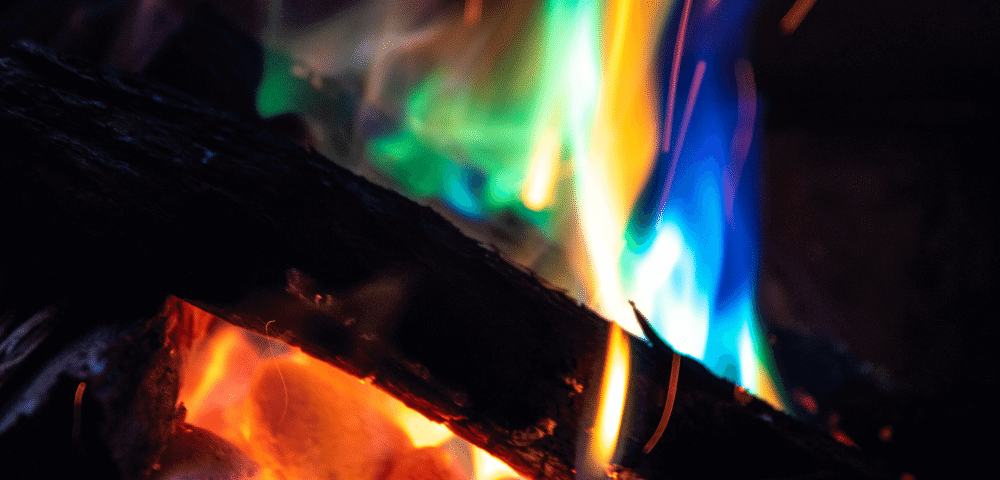If you’re like most people, you’re probably used to seeing the yellow or orange flames of campfires and traditional fireplaces.
So when you see color out of the ordinary, you’ll probably think that there’s something wrong with your gas fireplace.
Have you ever asked yourself, “why do gas fireplaces have a blue flame?” Well, you’ve come to the right place.
The short answer to this is the fact that natural gases burn at different temperatures, which lead to color changes in flames.
Below is a more detailed answer to why gas fireplaces produce blue flames.
How to adjust gas fireplace flame color
As we’ve explained later in the article, blue gas flames are regarded as safe and healthy.
But when gas fireplaces aka vent fireplaces, were invented, manufacturers considered that users were likely to yearn for the wood-burning color and feel.
It’s why most fireplaces produce a blue gas flame with tips that have an orange or yellow color.
If upon igniting your gas log fires, the color remains predominantly blue, there’s something you can do to change this. Here are the steps you should take:
Step 1: Locate the gas control knob
The first thing you need to do is figure out where the gas log control knob is positioned. As implied in its name, this is the part that regulates exactly how much gas your fireplace uses.
The knob is typically a round, and decorative slot that’s located close to the fireplace, either to its immediate right, left, or on the floor.
Step 2: Light the gas fireplace
Once you’ve located the control knob, light up your fireplace by twisting the knob to the right setting. With most fireplaces, there’ll be three main settings: on, off, and pilot.
Turn your knob to the pilot setting, then manually push it in. Doing so allows gas to flow into the system.
Finally, use a sparker or match to ignite the pilot light, and check whether the gas flame burns blue or a different hue.
It’s not unusual to observe a flame that’s blue with orange tips within the first few seconds of igniting.
But once the dust in air particles is burnt off, the flames should have yellow-orange tips. If this is not the case, check the following.
Step 3: Adjust the damper
If you’re not very familiar with gas fireplaces, you might be wondering what a damper is.
Well, this is a simple device located in a chimney’s flue. It’s the part that controls the movement of gases, byproducts, and air.
When it’s open, it lets gases and byproducts released from the combustion process to be vented out.
And when it’s closed, it ensures that air doesn’t escape the building, more so when the fireplace is idle.
You can decide how strongly the fire burns by adjusting the damper, which then allows either more or less oxygen to flow through the fire.
Depending on these adjustments, the gas flames will turn to the right color.
Step 4: Observe
Once you’ve made the necessary adjustments, it’s important that you allow enough time to pass before observing color changes.
Ideally, you should wait at least 30 minutes to see if the flame turns to the right color.
Step 5: Inspect your chimney or air vent
In the event that you don’t get the recommended blue flame with orange/yellow tips, there’s one more thing you can do to alter this.
This next step requires you to completely turn off the fireplace.
Give it ample time to cool, then do routine maintenance and inspection on your fireplace’s ventilation system.
Poor ventilation can prevent the fire from getting the right air-fuel mix required for proper ignition.
What color does methane burn?
Natural gas burns blue or with a shade close to blue. Be sure to pay attention to the color of your gas log fireplace flame. It could mean the difference between complete and incomplete combustion.
Why is gas fireplace flame blue instead of yellow?
The best way to explain why a gas fireplace produces a blue flame color is to start with the basics.
The process that results in these color changes is known as combustion. It’s the reaction that takes place when natural gas is combined with an antioxidant element like oxygen.
This combustion process produces heat (which you can easily feel) and light (which you see in the form of flames).
The flames take on different colors, and this depends primarily on temperature and the chemical composition of the fuel.
Temperature
When you burn natural gas at temperatures that range between 980°F and 1800°F, the flame takes on a red hue. At higher temperatures of between 2000°F and 2200°F, you’re likely to get an orange flame or a yellow gas flame.
Once the temperature gets closer to the 2400°F mark, the flames turn white. Another color you’re very likely to see is blue.
Usually, a blue flame is produced when the natural gas burns at temperatures as high as 2600°F to 3000°F. Ideally, this is the right flame color that should result from a gas fireplace, and we’ll explain the reason in a bit.
Fuel composition
While the differences in temperature are the core reason for varying flame colors, the composition of the fuel also plays a role.
For instance, fossil fuels like oil and natural gas comprise hydrocarbons. These compounds emit a defined line emission spectrum that’s blue in color.
On the other hand, if the fuel contains additional chemical elements, these will emit their own exceptional wavelengths of light.
For example, lithium produces a red flame, sodium a yellow flame, and barium a green flame.
Is blue flame safe in a gas fire?
Yes, blue is precisely the color you want to see coming from your fireplace as opposed to a yellow gas flame.
A blue flame indicates these three things:
- Complete combustion is taking place
- Proper heat is being produced
- Fuel is being used efficiently
Anytime you see a blue flame appear, it’s an indication that combustion is occurring efficiently. As a result, there’s no gas that’s being wasted.
This phenomenon applies to fuel as well. A blue flame indicates that the burner is using the least amount of fuel possible to keep the fire burning.
Lastly, blue flames are the hottest as they’re produced when there’s a sufficient amount of oxygen being supplied to the fire.
If the flames are predominantly a different color, it signals incomplete combustion meaning that the amount of heat being generated is not at its peak.
Why are blue flames safer?
If you notice a blue flame coming from your fireplace, you can rest easy knowing that there’s sufficient oxygen for complete combustion.
Put simply; there’s more than enough oxygen flowing into the fire, hence, it burns the fuel completely.
This results in the efficient use of both gas and fuel and allows for the production of the right byproducts.
As we stated earlier, fuels like natural gas consist of hydrocarbons, which are basically hydrogen and carbon.
When complete combustion occurs, the carbon gets oxidized to form carbon dioxide. The hydrogen also undergoes oxidation to form water, which appears in the form of water vapor.
If the gas flame takes on a different color, this should be a concern.
For instance, if you get yellow flames, this indicates incomplete combustion. This then means that you’re wasting gas, and not getting maximum value for your money.
More importantly, a yellow flame produces harmful byproducts. Instead of hydrocarbons being oxidized to form carbon dioxide, poisonous carbon monoxide gas and carbon are produced.
The carbon is released in the form of soot while the carbon monoxide is in gaseous form.
Carbon monoxide is a toxic gas that can cause severe side effects upon inhalation.
The side effects from carbon monoxide poisoning can range from dizziness to disorientation, unconsciousness, and in worst-case scenarios, death.
How do I get rid of the blue flame on my gas fireplace?
As we’ve already mentioned, blue flames are an indication that you’re using a healthy fire. So you should not set out to get rid of these blue flames in the first place.
What you should get rid of are flames that take on orange or yellow colors because they signal incomplete combustion.
Conclusion
Ever wondered why gas fireplaces have a blue flame? Well, when natural gases like methane burn at temperatures of up to 2600°F to 3000°F, the color of the resulting flames change.
To be more specific, the gas flame appears blue, which is actually a good thing.
It means that the methane mix with sufficient oxygen, to burn fuel completely to carbon dioxide and water vapor.
If you get orange or yellow flames instead, it means the fuel fails to burn completely, producing dangerous carbon monoxide.


